Image Caption: Ferret lung infected with canine distemper virus. Credit: Dr Stephen McQuaid & Stewart Church / QUB. Attribution 4.0 International (CC BY 4.0)
LUNG-ON-A-CHIP MODEL PACK
Culture your lung cells in a physiological air-liquid interface
Continuous and controlled supply of nutrients in a stable flow
Stop losing your cell experiment due to clogging
Choose the best parameters for your experiment
Why use a lung-on-a-chip model?
The limitations of current models for pathology research and drug discovery and screening are well-known. The standard culture of cells in static conditions has allowed the biomedical field to advance quickly, but it is a reductionist approach that cannot, by design, take into account most of the complexity in vivo [1].
Animal models do offer such complexity; however, the specificities of each species result in poor translation into humans and a huge loss of time and resources when moving from preclinical to clinical studies [2, 3].
The same is true in research focused on the respiratory tract. The lungs are one of the interfaces between the external environment and the body, being subjected to an air-liquid interface in a complex 3D structure, liquid flow, and constant mechanical stimulus.
These features are difficult to reproduce in in vitro models, as shown by Francis et al., in the table below [4]. The lung-on-a-chip model, based on the organ-on-chip technology derived from microfluidics, is the closest model to reproduce the in vivo setting in vitro without translational and ethical issues.
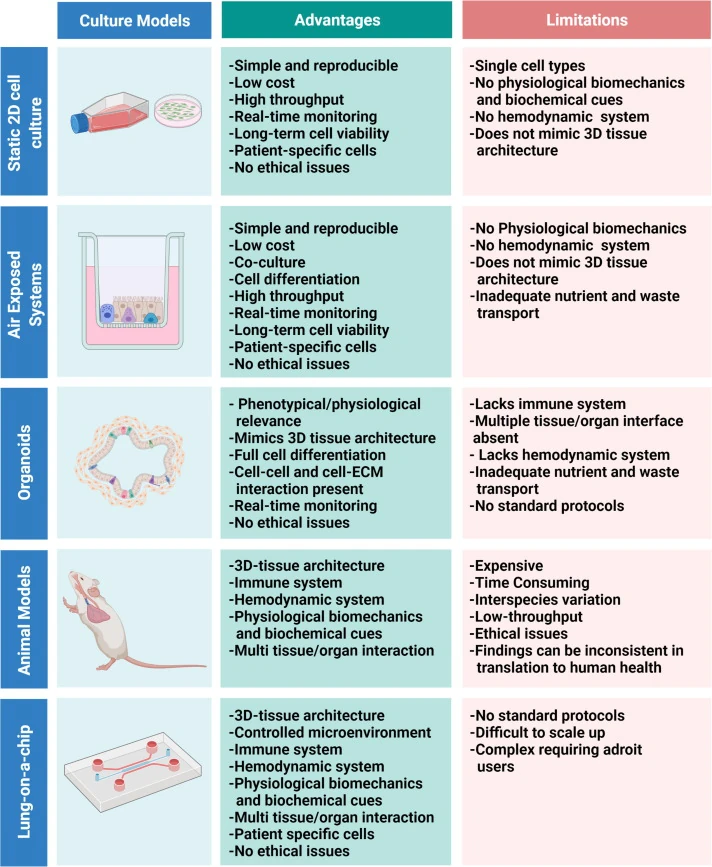
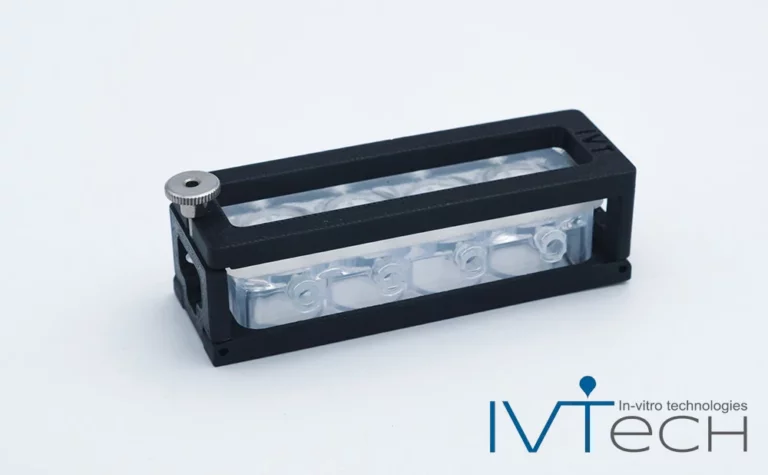
MultiDyn cell culture chamber
The Microfluidics Innovation Center partnered with IVTech, a biotechnology company specializing in advanced cell culture chambers to refine in vitro models. MultiDynm, an evolution of the LiveBox1 chamber, has been designed and produced by IVTech SRL. The system is a rack of 4 wells in parallel, compatible in dimension with the column of a standard 24-well plate.
MultiDyn assures the opportunity to recreate all the experiments performed with LiveBox1, replicating the data in 4 parallel tests and reducing the complexity of the chamber setup. The rack is monitorable in real-time, using an inverted microscope, assuring the possibility of developing a 3D in-vitro model in dynamic conditions.
References
1. Mehling, Matthias, and Savaş Tay. “Microfluidic cell culture.” Current opinion in Biotechnology 25 (2014): 95-102.
2. Hoeck, Katrin. “How the Right In Vitro Biological Model Can Drive Success in Drug Discovery: Advanced physiologically relevant in vitro model systems can help predict the efficacy and safety of drug candidates early in the drug discovery process, reducing attrition rates.” Genetic Engineering & Biotechnology News 40.11 (2020): 19-21.
3. Van Norman, Gail A. “Limitations of animal studies for predicting toxicity in clinical trials: is it time to rethink our current approach?.” JACC: Basic to Translational Science 4.7 (2019): 845-854.
4. Francis, Isabella, et al. “Recent advances in lung-on-a-chip models.” Drug Discovery Today 27.9 (2022): 2593-2602.
Lung-on-a-chip pack setup
The lung-on-a-chip model can be perfused in a microfluidic chip for several days with a minimal volume of medium by using two media perfusion loops that can be integrated into our automated cell culture platform. To achieve that, this platform is based on the high-accuracy OB1 flow controller, a recirculation loop, flow sensors and level sensors.
With these additional features, the success of your microfluidic perfusion system is no longer dependent on the stability of your system’s fluidic resistance. In other words, you don’t need to worry about air entering your lines and damaging your cell culture due to fouling or clogging of the tubing!
In summary, the lung-on-a-chip model setup comprises the following instruments:
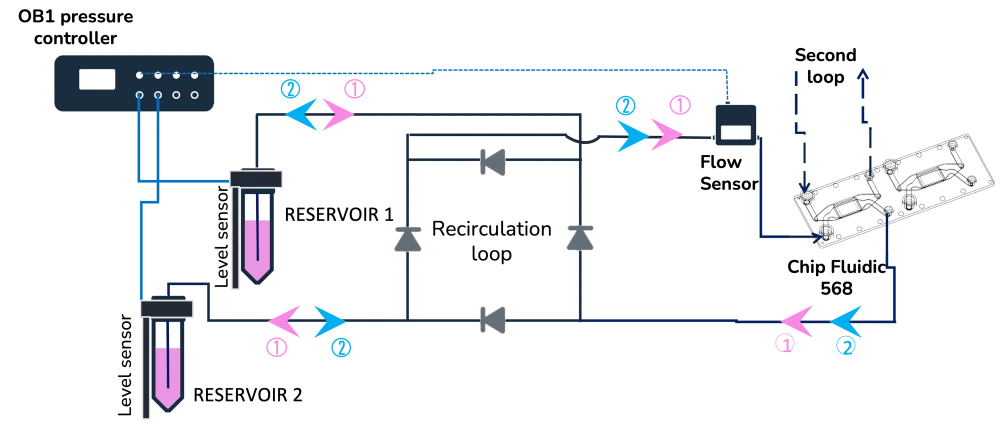
A typical lung-on-a-chip pack contains:
- OB1 flow controller (Elveflow)
- Several Falcon reservoirs
- Recirculation loop
- Tubings and fittings
- Level sensors
- Microfluidic chip (Suggestion: ChipShop Fluidic 568)
- ESI software (Elveflow)
- User guide
Lung-on-a-chip principle
The lungs are a barrier between the external and internal environments of the body, being characterized by an air-liquid interface. A lung-on-a-chip model reproduces this interface with a membrane chip, where one side of the membrane is flushed with air and the other with cell culture media or a blood-equivalent fluid. Each side of this membrane is laden with the appropriate cell types, and mechanical stimulus can be applied if the chip’s material is flexible.
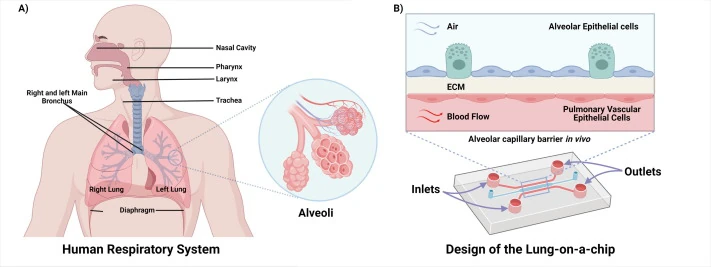
Lung-on-a-chip applications
Deinhardt-Emmer et al. [2] developed a human alveolus-on-a-chip model using a membrane chip similar to the one suggested in this Pack. The goal was to develop a more physiologically-relevant model comprising endothelial and epithelial cells and macrophages to resemble the human alveolus architecture and functions.
The figure below shows each side of the membrane, using immunostaining to characterize each cell type. This same model was later used to study the inhibition effects of Pictilisib on influenza virus propagation [3] and to understand how the Sars-Cov-2 virus crosses the alveolar barrier to cause severe COVID-19 [4].
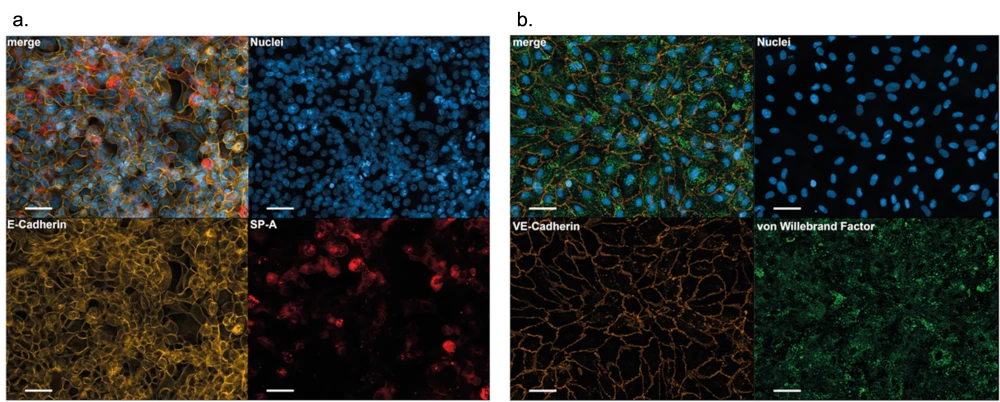
References
1. Francis, Isabella, et al. “Recent advances in lung-on-a-chip models.” Drug Discovery Today 27.9 (2022): 2593-2602.
2. Deinhardt-Emmer, Stefanie, et al. “Co-infection with Staphylococcus aureus after primary influenza virus infection leads to damage of the endothelium in a human alveolus-on-a-chip model.” Biofabrication 12.2 (2020): 025012.
3. Deinhardt-Emmer, Stefanie, et al. “Inhibition of phosphatidylinositol 3-kinase by pictilisib blocks influenza virus propagation in cells and in lungs of infected mice.” Biomolecules 11.6 (2021): 808.
4. Deinhardt-Emmer, Stefanie, et al. “SARS-CoV-2 causes severe epithelial inflammation and barrier dysfunction.” Journal of virology 95.10 (2021): 10-1128.
Customize your pack
Our instruments are compatible with any standard commercialized chips from different brands.
Our Packs can be modified depending on your specific needs. In this light, our microfluidic specialists will advise you on the best instruments and accessories depending on your needs and will accompany you during the setup of the microfluidic platform.
– Check our other Packs for various applications –
How can we help your experiment?
The packs applications are still under development, so we are not able to give you the tips or troubleshooting advice that we usually give in our user guides and application notes for the possible challenges you could face for a specific application experiment. That being said, we can always guarantee reliable and high-precision microfluidic flow control. Our microfluidic instruments are high-performance, versatile and user-friendly. Our experts will bring support and expertise during the setup and implementation of this sensor calibration pack.
Can the pack be customized based on my sepcific application?
Yes! Our experts will establish which instruments are best suited for your application, such as the type of flow sensor or the number of flow controller channels you need to perform your experiment. Send us a message:
Can I buy individual instruments?
You can order our instruments on the product section of our website.
Funding and Support
The ALTERNATIVE and LIFESAVER projects helped develop this instrument pack. These projects are funded by European Union’s H2020-LC-GD-2020-3, grant agreements No. 101037090 (ALTERNATIVE) and 101036702 (LIFESAVER).


